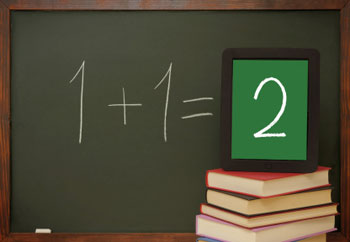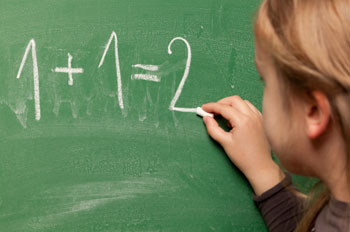Math Dictionary for 7th Grade Students
Proper equipment is needed to succeed in any field. In football, you need a helmet; in art, you need a paintbrush. And in seventh grade math, you'll likely need a dictionary. Keep reading to learn how you can build your own math dictionary, as well as how to define some of the terms you might encounter in seventh grade.

How to Write Your Own Math Dictionary
In seventh grade, you'll learn about ratios, percentages, statistics and geometry. It can be hard to keep track of the many vocabulary words associated with these branches of math, but creating your own math dictionary might help you stay on top of the material. You should remember that your teacher and your textbook are resources available to you while recording your list of math terms.
You can begin constructing your dictionary by writing the definitions for various math terms in your own words, using language that you understand. You also might draw pictures and/or provide examples to help you visualize the term. Additionally, you could use different colors to accent certain aspects of your definition. For example, if you draw a graph, you can use different colors to identify its various parts, such as the x-axis, y-axis and coordinates.
Some other suggestions for creating your math dictionary include:
- Keep your list of vocabulary words in the back of your math notebook for easy access during class and homework time.
- Organize your list by underlining vocabulary words and skipping lines between words.
- Highlight vocabulary terms in each use to make them stand out on the page.
Sample 7th Grade Math Terms by Branch
Geometry
Congruent
Adjective
- Equal in shape and size. Two objects are congruent if they match exactly when one is placed directly on top of the other.
Parallel
Adjective
- Extending in the same direction while remaining the same distance from one another. For example, train tracks are parallel.
Polygon
Noun
- A closed figure that has edges that are all straight lines. Polygons are classified by the number of sides and angles that they have. Triangles and squares are two examples of polygons.
Quadrilateral
Noun
- A 2-dimensional figure with four straight sides. The interior angles of a quadrilateral add up to 360 degrees. These figures include trapezoids, parallelograms, rhombuses, rectangles and squares.
Ratios and Proportions
Equivalent Ratio
Noun
- A ratio describes the relationship between two quantities. Equivalent ratios are ratios that represent the same relationship. For example, 1:2 and 2:4 are equivalent ratios. To find an equivalent ratio, multiply or divide both sides of a ratio by the same number. In the instance above, you would multiply both sides of the ratio 1:2 by two to reach the equivalent ratio 2:4.
Unit Rate
Noun
- A rate is a type of ratio that uses different units of measure. A unit rate is a ratio in which the second term is one unit. For example, if a car gets 30 miles to the gallon of gas, the unit ratio would be 30:1.
Statistics and Probability
Factorial
Noun
- The product of a specified positive integer and all the positive integers less than it. For example, to determine the factorial of five (written 5!), you would multiply 5 x 4 x 3 x 2 x 1. The answer is 120.
Mean
Noun
- The value reached by adding the numbers in a data set and then dividing that sum by the number of values in the set. It also might be called the 'arithmetic mean' or 'average.'
Median
Noun
- The middle number in a data set. To find the median, the numbers in a data set must be organized from smallest to largest. For example, the median of the data set 17, 23, 39, 48 and 57 would be 39.
Other Articles You May Be Interested In
-
MIND Games Lead to Math Gains

Imagine a math teaching tool so effective that it need only be employed twice per week for less than an hour to result in huge proficiency gains. Impossible, you say? Not so...and MIND Research Institute has the virtual penguin to prove it.
-
Should Math Be a Main Focus in Kindergarten?

Should kindergartners put away the building blocks and open the math books? According to recent research, earlier is better when it comes to learning mathematical concepts. But that could put undue pressure on kids, parents and even teachers.
We Found 7 Tutors You Might Be Interested In
Huntington Learning

- What Huntington Learning offers:
- Online and in-center tutoring
- One on one tutoring
- Every Huntington tutor is certified and trained extensively on the most effective teaching methods
K12

- What K12 offers:
- Online tutoring
- Has a strong and effective partnership with public and private schools
- AdvancED-accredited corporation meeting the highest standards of educational management
Kaplan Kids

- What Kaplan Kids offers:
- Online tutoring
- Customized learning plans
- Real-Time Progress Reports track your child's progress
Kumon

- What Kumon offers:
- In-center tutoring
- Individualized programs for your child
- Helps your child develop the skills and study habits needed to improve their academic performance
Sylvan Learning

- What Sylvan Learning offers:
- Online and in-center tutoring
- Sylvan tutors are certified teachers who provide personalized instruction
- Regular assessment and progress reports
Tutor Doctor

- What Tutor Doctor offers:
- In-Home tutoring
- One on one attention by the tutor
- Develops personlized programs by working with your child's existing homework
TutorVista

- What TutorVista offers:
- Online tutoring
- Student works one-on-one with a professional tutor
- Using the virtual whiteboard workspace to share problems, solutions and explanations